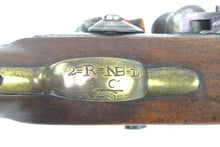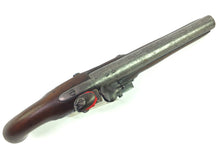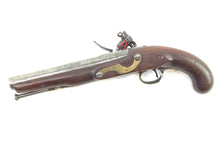
A 1796 Flintlock Heavy Cavalry Pistol to The Royal Scots Greys.
Missed out on this item? Click to view all current Antique Pistols & Revolvers Free UK delivery on all items
15 ½” overall, 9” round musket bore barrel with Kings proof marks, double line border engraved lockplate engraved Tower at the tail, crown GR, broad arrow ordnance mark, border engraved swan neck cock. Regulation brass furniture comprising trigger guard engraved ‘2RNBD’ (2nd Royal North British Dragoons) ‘C45’. ‘S’ shaped sideplate and single ramrod pipe with original steel ramrod. Walnut full stock.
Circa1800
In good condition.
Ex Clive Brook Collection
See British Ordnance Single Shot Pistols by Dais, Chisnall and Brooks, Chapter 3, page 11 for this pistol.
Originally raised in 1678, this famous Dragoon regiment became The Royal North British Dragoons in 1707 and then the 2nd Dragoons when the English and Scottish armies were merged in 1713. Mounted on grey horses, they were already being called the “Grey Dragoons” by this time. Officially known as the 2nd Royal North British Dragoons by the time of the Napoleonic Wars, they were nicknamed the “Scots Greys” or “Royal Scots Greys”.
After participating in Britain’s unsuccessful campaign in Flanders in 1794, the Scots Greys returned to home station and only returned to the Continent in the spring of 1815 when they joined Wellington’s army facing Napoleon. The regiment became part of the Union Brigade so named because it consisted of British (Royals), Scottish (Scots Greys) and Irish (6th Inniskilliing Dragoons) regiments. The Scots Greys gained immortal fame in the charge of the Union Brigade that smashed the main French infantry attack by General d’Erlon’s Corps, but this triumph came at a high price – 102 dead and 97 wounded. During this charge, Sergeant Charles Ewert of the Scots Greys captured the eagle of the 45th Regiment. Despite their heavy losses, the Scots Greys remained in action for the rest of the battle, carrying out several smaller charges late in the day.











